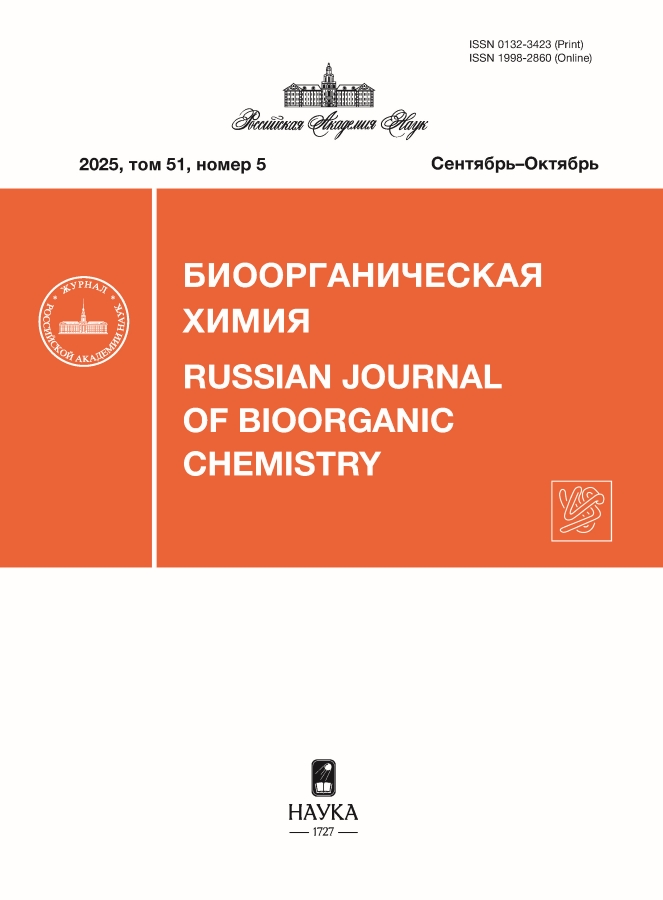Targeted Nanoliposomes Loaded with IR780 Dye as a Multifunctional Nanoplatform for Photothermal and Photodynamic Cancer Therapy
- Autores: Proshkina G.M1, Shramova E.I1, Sogomonyan A.S1,2, Deyev S.M1,2,3
-
Afiliações:
- Shemyakin–Ovchinnikov Institute of Bioorganic Chemistry, RAS
- Moscow Institute of Engineering Physics, National Research Nuclear University "MEPhI"
- Ogarev National Research Mordovian State University
- Edição: Volume 51, Nº 5 (2025)
- Páginas: 882-891
- Seção: ЭКСПЕРИМЕНТАЛЬНЫЕ СТАТЬИ
- URL: https://consilium.orscience.ru/0132-3423/article/view/695715
- DOI: https://doi.org/10.31857/S0132342325050132
- ID: 695715
Citar
Texto integral
Resumo
During cancer treatment the combined effect of photothermal and photodynamic therapy has unique advantages over each of these methods alone. In this study, a multifunctional targeted nanoplatform for simultaneous combined photothermal and photodynamic therapy under 808 nm infrared laser irradiation was developed. The developed system consists of ~140 nm liposomes specific to the tumor-associated HER2 antigen and loaded with the near-infrared heptamethincyanine dye IR780. The targeting of liposomes to the HER2 is determined by the HER2-specific scaffold protein DARPin_9-29 located on the outer surface of liposomes. It has been established that IR-780, loaded in liposomes, retains photothermal and photodynamic properties: upon irradiation, the temperature of IR780-loaded liposome solution rapidly increases (up to 60°C within 60 s), and the production of reactive oxygen species is also detected. In vitro experiments have shown that HER2-specific liposomes containing IR780 have photoinduced cytotoxicity against HER2-overexpressing cells, causing the death of 50% of the cell population at a concentration of 2.85 μM. The results of the study suggest that HER2-specific liposomes containing IR780 have excellent targeted characteristics, and IR780 can be used as an active substance for simultaneous photothermal and photodynamic therapy.
Palavras-chave
Sobre autores
G. Proshkina
Shemyakin–Ovchinnikov Institute of Bioorganic Chemistry, RAS
Email: gmb@ibch.ru
Moscow, Russia
E. Shramova
Shemyakin–Ovchinnikov Institute of Bioorganic Chemistry, RASMoscow, Russia
A. Sogomonyan
Shemyakin–Ovchinnikov Institute of Bioorganic Chemistry, RAS; Moscow Institute of Engineering Physics, National Research Nuclear University "MEPhI"Moscow, Russia; Moscow, Russia
S. Deyev
Shemyakin–Ovchinnikov Institute of Bioorganic Chemistry, RAS; Moscow Institute of Engineering Physics, National Research Nuclear University "MEPhI"; Ogarev National Research Mordovian State UniversityMoscow, Russia; Moscow, Russia; Saransk, Russia
Bibliografia
- Sung H., Ferlay J., Siegel R.L., Laversanne M., Soerjomataram I., Jemal A., Bray F. // CA Cancer J. Clin. 2021. V. 71. P. 209–249. https://doi.org/10.3322/caac.21660
- Goto T., Saito H., Sasajima J., Kawamoto T., Fujinaga A., Utsumi T., Yanagawa N., Hiramatsu K., Takamura A., Sato H., Fujibayashi S., Fujiya M. // Front. Oncol. 2020. V. 10. P. 597813. https://doi.org/10.3389/fonc.2020.597813
- Nausea and Vomiting Related to Cancer Treatment (PDQ(R)): Health Professional Version // PDQ Cancer Information Summaries. Bethesda (MD), 2002.
- Wikramanayake T.C., Haberland N.I., Akhundlu A., Laboy Nieves A., Miteva M. // Curr. Oncol. 2023. V. 30. P. 3609–3626. https://doi.org/10.3390/curroncol30040275
- Demoor-Goldschmidt C., de Vathaire F. // Br. J. Radiol. 2019. V. 92. P. 20180390. https://doi.org/10.1259/bjr.20180390
- Yoo S.W., Oh G., Ahn J.C., Chung E. // Biomedicines. 2021. V. 9. Р. 113. https://doi.org/10.3390/biomedicines9020113
- Han H.S., Choi K.Y. // Biomedicines. 2021. V. 9. Р. 305. https://doi.org/10.3390/biomedicines9030305
- Sun J., Zhao H., Xu W., Jiang G.Q. // Front. Chem. 2022. V. 10. P. 1024177. https://doi.org/10.3389/fchem.2022.1024177
- Шрамова Е.И., Котляр А.Б., Лебеденко Е.Н., Деев С.М., Прошкина Г.М. // Act. Nat. 2020. V. 12. P. 81–91. https://doi.org/10.32607/actanaturae.11028
- Proshkina G.M., Shramova E.I., Serova E.V., Myachev E.A., Mirkasymov A.B., Deyev S.M., Kotlyar A.B. // J. Nanotheranostics. 2025. V. 6. P. 2.
- Lin J., Wang S., Huang P., Wang Z., Chen S., Niu G., Li W., He J., Cui D., Lu G., Chen X., Nie Z. // ACS Nano. 2013. V. 7. P. 5320–5329. https://doi.org/10.1021/nn4011686
- Zhang M., Murakami T., Ajima K., Tsuchida K., Sandanayaka A.S., Ito O., Iijima S., Yudasaka M. // Proc. Natl. Acad. Sci. USA. 2008. V. 105. P. 14773– 14778. https://doi.org/10.1073/pnas.0801349105
- Tian B., Wang C., Zhang S., Feng L., Liu Z. // ACS Nano. 2011. V. 5. P. 7000–7009. https://doi.org/10.1021/nn201560b
- Wang K., Zhang Y., Wang J., Yuan A., Sun M., Wu J., Hu Y. // Sci. Rep. 2016. V. 6. P. 27421. https://doi.org/10.1038/srep27421
- Gutierrez C., Schiff R. // Arch. Pathol. Lab. Med. 2011. V. 135. P. 55–62. https://doi.org/10.5858/2010-0454-RAR.1
- Blumenthal G.M., Scher N.S., Cortazar P., Chattopadhyay S., Tang S., Song P., Liu Q., Ringgold K., Pilaro A.M., Tilley A., King K.E., Graham L., Rellahan B.L., Weinberg W.C., Chi B., Thomas C., Hughes P., Ibrahim A., Justice R., Pazdur R. // Clin. Cancer Res. 2013. V. 19. P. 4911–4916. https://doi.org/10.1158/1078-0432.CCR-13-1212
- Steiner D., Forrer P., Pluckthun A. // J. Mol. Biol. 2008. V. 382. P. 1211–1227. https://doi.org/10.1016/j.jmb.2008.07.085
- Deyev S., Proshkina G., Baryshnikova O., Ryabova A., Avishai G., Katrivas L., Giannini C., Levi-Kalisman Y., Kotlyar A. // Eur. J. Pharm. Biopharm. 2018. V. 130. P. 296–305. https://doi.org/10.1016/j.ejpb.2018.06.026
Arquivos suplementares










